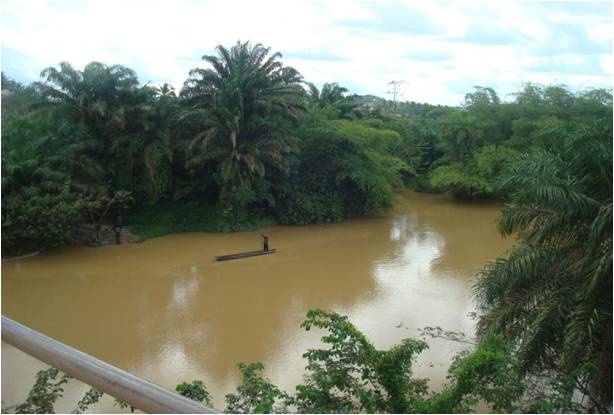
In the Wassa Amenfi East District of the Western Region of Ghana, only one per cent (or one in hundred) communities have access to uncontaminated or safe drinking water.
According to Nana Akua Ampoma II, Queenmother for Dawurampong, the situation in the Wassa Amenfi East District is so dire that famers in the area cannot drink from streams when they go to the farm. Instead, they have to go along with enough sachets of water to last them the period they would be on the farm.

This is the kind of water some Ghanaians are drinking
Besides, families are put in the stressful situation of waiting upon their soups to cool off and suspend before scooping the watery portion for consumption. If they did otherwise, she said, they risked consuming dust and other particles.
The Queenmother shared this story last Friday in Accra where she joined 46 other participants in a “National stakeholders’ forum on the impact of small scale mining activities on water quality in the communities of Wassa Amenfi East District.”
Nana Akua Ampoma II narrated that at Adanse, a community in the area under discussion, the people do not have access to a good source of water except for a stream source that appears creamier than milk.
Alice Ketu (also of Dawurampong) and Ebenezer Frimpong (of Wassa Babianiha) corroborated the queenmother’s story and blamed the situation on activities of illegal small scale miners, including Ghanaians and Chinese.
A visibly frustrated Alice inquired: “Every time we meet at forums like this we always call on government. I wonder, doesn’t government hear all our appeals?
Friday’s forum was organised by the Coalition of NGOs in Water and Sanitation (CONIWAS) as a follow up to community level engagements and research activities which were all part of the “Deepening linkages between Research, Advocacy and Media practitioners in Ghana for greater policy influence and impact” project.
The project is a tripartite effort between research, advocacy and media institutions and specifically has CONIWAS, Water Research Institute of the Council for Scientific and Industrial Research (CSIR-WRI), Public Agenda newspaper and Ghana News Agency (GNA) as partners. SEND-Ghana coordinates the project while the Southern African Trust Fund plays the funder’s role.
According to a policy brief titled “Impact of Small-Scale Mining Activities on the Water Quality in the Communities of Wassa Amenfi East District,” which was shared with participants at Friday’s forum, studies by the CSIR-WRI have established that activities of illegal small scale miners, popularly known as ‘galamsey’, are polluting water bodies and threatening the health of the citizens in the area.
“Results from studies carried out… on the Hiawa River which is a tributary to the Ankobra River at Wassa Akropong and also being used by the citizens of the town for drinking and other domestic purposes recorded very high levels in colour, turbidity [muddiness] and total suspended solids,” the authors reported.
“The levels recorded were far above World Health Organisation’s (WHO) recommended levels.”
Jointly explaining the CSIR-WRI’s findings in a presentation, Messrs Samuel Obiri and Mark Akrong said the entry of Chinese into the mining sector may have aggravated the situation as the use of machines made of Chinese technology for gold mining in rivers have caused landslides into river Ankobra, worsening the state of the already polluted river.
Expert analysis shows that gold mining brings with it arsenic, mercury and sulphur contamination of water bodies, soil and even air. It has been established that mercury vapour inhalation can cause memory and speech loss, numbness, vision problems, convulsion and in some cases death.
Meanwhile, the Centre for Environmental Impact Analysis (CEIA) mentions that many people could have been poisoned through consumption of water sourced from more than 260 rivers and streams in the Obuasi and Tarkwa mining areas because these have been found to be polluted.
A baseline study conducted by CEIA and Wacam in 2008 revealed, among others, that 145 out of the 160 streams/rivers in Obuasi mining area as well as all 117 rivers/streams in the Tarkwa mining area were perceived to be polluted by mining companies and galamsey operators.
Presenting on the “Impact of mining activities on health and livelihood of communities located in mining environment,” Ms Dzifa Dadzie, Programme Officer of CEIA, said further studies by the Centre had confirmed, through water and blood samples taken from some people in the Tarkwa and Prestea areas, that there were elevated levels of toxic chemicals and exposure to the toxic chemicals would pose significant health hazard to resident adults, children and mine workers.
Emerging from the various presentations and discussions were suggestions that the inter-ministerial task force on mining should be decentralized to involve district level agencies and communities. In addition, participants asked for the setting up of a unit to protect water bodies.
Earlier, Ms Suzzy Abaidoo, who represented the Water Directorate of the Ministry of Water Resources, Works and Housing (WD-MWRWH), said water quality had become a major issue, even at the global level. She noted that in Ghana poor water quality was not only attributable to pollution by miners but also to human activities such as farming close to water bodies.
Consequently, she said the Directorate was determined to curb the menace by beginning with strategies that could assist prevent water resource from getting polluted.

Leave A Comment